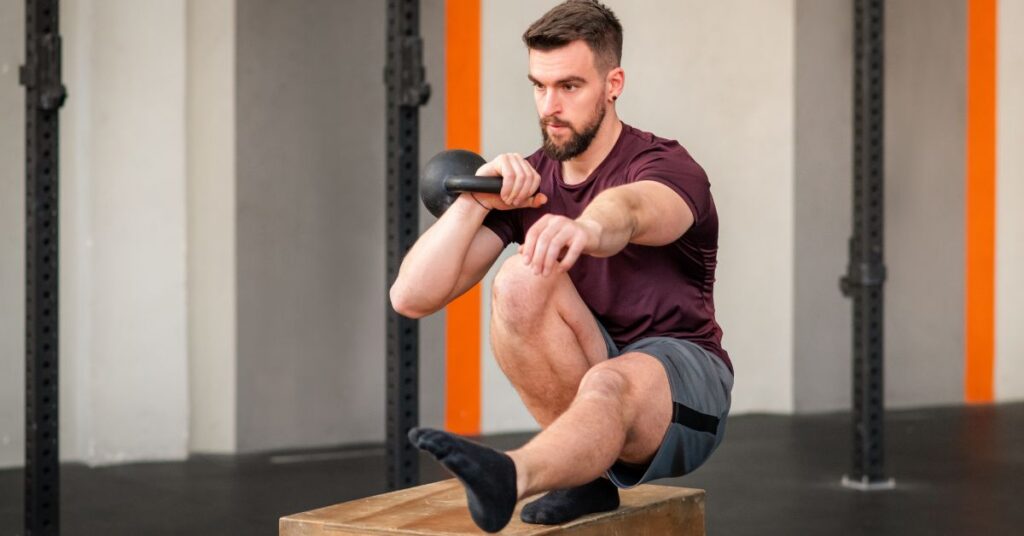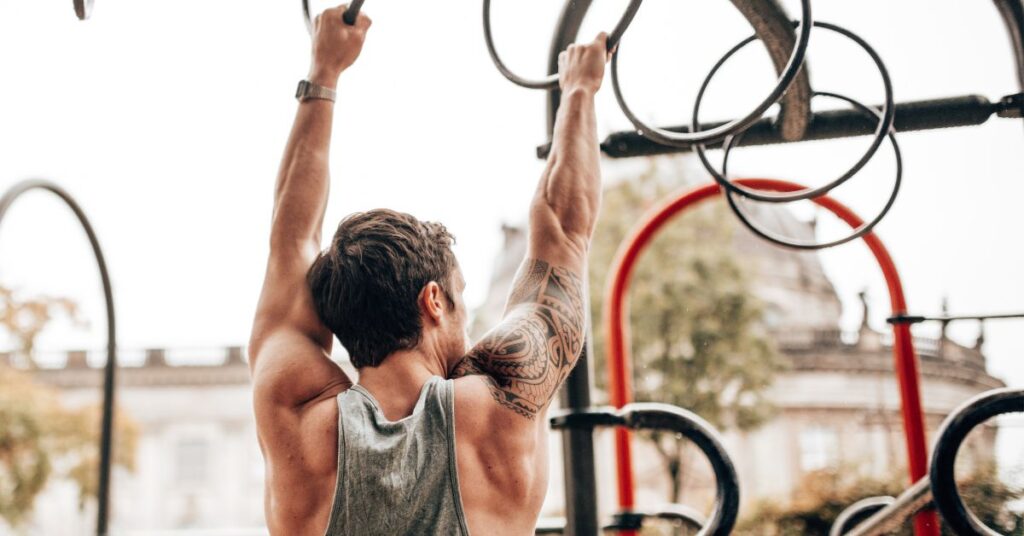12 Calisthenics Biceps Exercises are Chin-Ups, Inverted Rows, Reverse Grip Push-Ups, Isometric Pull-Ups, Headbangers, Bodyweight Bicep Curls, One-Arm Chin-Up Negatives, Commando Pull-Ups, Australian Pull-Ups, Pelican Curls, Korean Dips, and Side Plank.
Building strong biceps through calisthenics means using natural bodyweight exercises instead of weights. calisthenics biceps approach exercises develops impressive arm strength using just your own body as resistance. This guide covers everything you need to know about effective bodyweight biceps training – from basic exercises to advanced techniques.
Table of Contents
12 Calisthenics Biceps Exercises
These carefully selected movements represent the most effective bodyweight exercises for bicep development, ranging from beginner-friendly to advanced variations. Each exercise targets the biceps through different angles and movement patterns, ensuring comprehensive muscle activation. Mastering these fundamental movements provides the foundation for building impressive arm strength and size without any equipment required.
Complete Exercise Overview
| Exercise | Difficulty Level | Primary Focus | Equipment Needed |
| Chin-Ups | Beginner-Intermediate | Primary bicep builder | Pull-up bar |
| Inverted Rows | Beginner | Biceps and back development | Horizontal bar |
| Reverse Grip Push-Ups | Intermediate | Bicep activation pattern | None |
| Isometric Pull-Ups | Intermediate | Time-under-tension | Pull-up bar |
| Headbangers | Advanced | Dynamic horizontal movement | Pull-up bar |
| Bodyweight Bicep Curls | Beginner-Intermediate | Isolation movement | Low bar/rings |
| One-Arm Chin-Up Negatives | Advanced | Unilateral strength | Pull-up bar |
| Commando Pull-Ups | Advanced | Coordination and strength | Pull-up bar |
| Australian Pull-Ups | Beginner | Endurance and pulling strength | Horizontal bar |
| Pelican Curls | Advanced | Extended range of motion | Parallel bars |
| Korean Dips | Advanced | Stabilization and range extension | Parallel bars |
| Side Plank | Beginner | Arm stability and endurance | None |
1. Chin-Ups
:max_bytes(150000):strip_icc()/chinup-86e9f2cd49a346389f3baf4a5f417a9c.jpg)
One of the most foundational calisthenics biceps exercises, chin-ups offer intense bicep engagement using just your bodyweight. With an underhand grip and proper form, this movement is essential for building size and strength in your upper arms.
Setup:
- Begin these foundational calisthenics exercises by finding a pull-up bar that allows for full range of motion.
- Position yourself directly under the bar to prepare for this effective calisthenics workout.
- Use a controlled jump to grasp the bar with an underhand grip that targets your biceps effectively.
- Set your hands slightly narrower than shoulder-width to maximize these introductory calisthenics biceps exercises.
Execution:
- Start with arms fully extended while maintaining proper body alignment during these calisthenics exercises.
- Draw your navel toward your spine and take a deep breath before beginning your calisthenics workout.
- Pull your shoulder blades down and back to establish stability for these progressive calisthenics biceps exercises.
- Execute a smooth, controlled pull upward while focusing intensely on bicep engagement.
- Continue pulling until your chin passes the bar height to complete each repetition effectively.
- Pause briefly at the top while squeezing your biceps during these fundamental calisthenics exercises.
- Lower yourself with deliberate control to maximize the benefits of these advanced calisthenics biceps exercises.
2. Inverted Rows

A powerful addition to your calisthenics biceps exercises routine, inverted rows work the biceps and back simultaneously. By adjusting your body angle, you can increase difficulty while maintaining muscle control and balance.
Setup:
- Begin these intermediate calisthenics exercises by setting a horizontal bar at waist height.
- Position yourself beneath the bar to prepare for this targeted calisthenics workout.
- Establish a firm underhand grip for optimal bicep engagement during these progressive calisthenics biceps exercises.
- Create a straight line from head to heels while maintaining proper body tension.
Execution:
- Start with fully extended arms while preparing for these foundational calisthenics exercises.
- Engage your core and glutes throughout your calisthenics workout progression.
- Pull your chest toward the bar with control during these effective calisthenics biceps exercises.
- Focus on driving your elbows down and back to maximize bicep activation.
- Touch your chest to the bar while maintaining proper form in these demanding calisthenics exercises.
- Hold briefly at the top to enhance muscle engagement during these advanced calisthenics biceps exercises.
- Lower yourself with controlled movement to complete each repetition effectively.
3. Reverse Grip Push-Ups
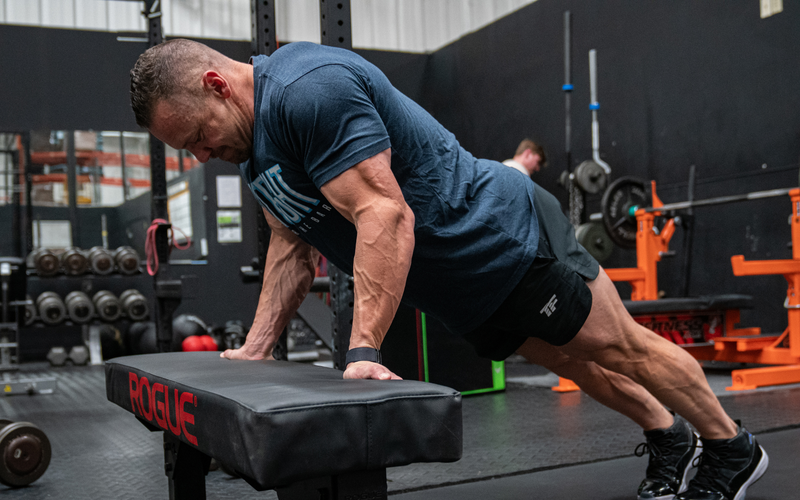
This variation transforms a standard push-up into a targeted calisthenics biceps exercise. The reverse hand position forces your biceps to activate throughout the push, making it a great bodyweight solution for arm gains.
Setup:
- Start in a push-up position while preparing for these unique calisthenics exercises.
- Rotate your hands 180 degrees to establish the proper grip for your calisthenics workout.
- Position hands slightly wider than shoulders during these demanding calisthenics biceps exercises.
- Keep elbows tucked close to your body throughout the movement pattern.
Execution:
- Lower your body with complete control while engaging your core muscles fully.
- Maintain a straight line from head to heels during these foundational calisthenics exercises.
- Continue lowering until your chest nearly touches the ground for maximum range of motion.
- Push back up smoothly while performing these progressive calisthenics biceps exercises.
- Focus on maintaining proper form throughout each repetition of the movement.
4. Isometric Pull-Ups

Static holds are underrated in calisthenics biceps exercises. Isometric pull-ups focus on time-under-tension, increasing muscular endurance and biceps definition by holding the top position of a chin-up.
Setup:
- Approach the pull-up bar to begin these advanced calisthenics exercises.
- Establish an underhand grip at shoulder width for your focused calisthenics workout.
- Pull yourself to the top position to prepare for these demanding calisthenics biceps exercises.
- Engage your core and back muscles to create complete body stability.
Execution:
- Maintain the top position while performing these challenging calisthenics exercises.
- Focus on maximum bicep contraction during your specialized calisthenics workout.
- Hold this position for your prescribed time during these controlled calisthenics biceps exercises.
- Lower yourself with deliberate control when completing each hold.
Pro Tips:
- Break longer holds into shorter segments while practicing these progressive calisthenics exercises.
- Try different hold angles to target various aspects of these effective calisthenics biceps exercises.
- Use a timer to track your progress accurately during each training session.
- Practice controlled breathing throughout your intense calisthenics workout.
5. Headbangers

A dynamic twist on chin-ups, headbangers challenge your biceps through horizontal movement. This advanced calisthenics biceps exercise emphasizes control and coordination while keeping the muscle under continuous tension.
Setup:
- Start in the top chin-up position for these dynamic calisthenics exercises.
- Establish a firm grip while preparing for your challenging calisthenics workout.
- Create full-body tension before beginning these powerful calisthenics biceps exercises.
- Position your shoulders down and back for optimal stability.
Execution:
- Maintain height while moving your head forward with complete control.
- Guide the movement until the bar reaches the back of your head.
- Return to the starting position during these intensive calisthenics exercises.
- Maintain constant tension throughout your focused calisthenics workout.
Pro Tips:
- Start with small movement ranges and gradually increase as you build control.
- Focus on maintaining consistent height throughout these advanced calisthenics biceps exercises.
- Keep your shoulders actively depressed away from your ears during movement.
- Control your movement speed to maximize the effectiveness of each repetition.
6. Bodyweight Bicep Curls
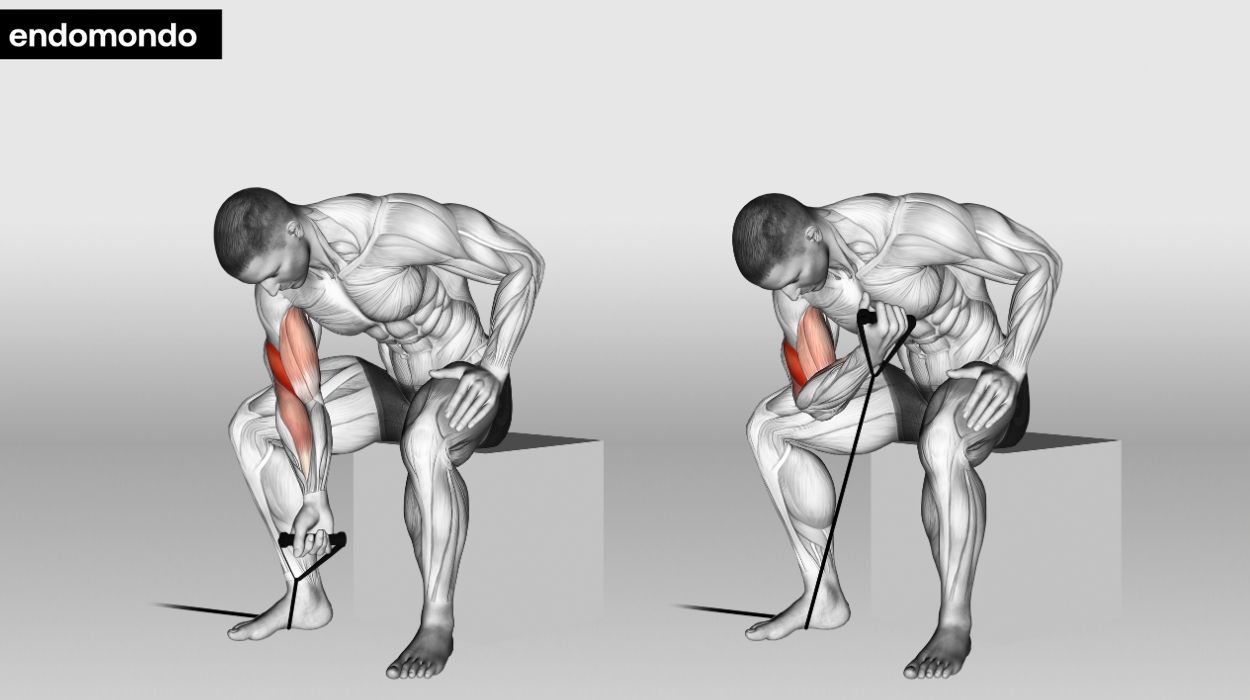
Bodyweight curls mimic the traditional dumbbell curl using rings or a low bar. As one of the most effective calisthenics biceps exercises, it isolates the arms and can be modified based on your strength level.
Setup:
- Find a sturdy, low bar suitable for these foundational calisthenics exercises.
- Grip the edge with palms facing up during your progressive calisthenics workout.
- Walk your feet forward to position yourself for these effective calisthenics biceps exercises.
- Create a strong base position before beginning the movement.
Execution:
- Begin with straight arms while maintaining optimal body alignment.
- Curl your body upward using controlled bicep activation during these targeted calisthenics exercises.
- Keep elbows fixed throughout the movement for maximum effectiveness.
- Lower yourself back to the starting position with deliberate control.
Pro Tips:
- Adjust your body angle to match your current strength level.
- Focus on squeezing your biceps at the top of each repetition.
- Maintain core engagement to prevent unwanted body swing.
- Practice steady breathing patterns throughout the exercise.
7. One-Arm Chin-Up Negatives

Negative reps are essential for building strength in calisthenics biceps exercises. The one-arm chin-up negative increases overload on a single arm, making it a perfect stepping stone to advanced skills.
Setup:
- Begin these challenging calisthenics exercises by reaching the top chin-up position.
- Prepare for your targeted calisthenics workout by establishing proper body position.
- Release one hand while maintaining these controlled calisthenics biceps exercises.
- Create full-body tension before initiating the lowering phase.
Execution:
- Start at the top position with complete muscular engagement.
- Lower yourself with maximum control during these progressive calisthenics exercises.
- Focus on a 5-10 second descent for these intense calisthenics biceps exercises.
- Land softly while maintaining proper form throughout your calisthenics workout.
Safety Considerations:
- Maintain complete shoulder control throughout the movement.
- Never sacrifice proper form for extended lowering times.
- Build strength progressively through consistent practice.
- Listen to your body and adjust intensity as needed.
8. Commando Pull-Ups

This intense variation adds a twisting motion, targeting both the biceps and core. Commando pull-ups stand out among calisthenics biceps exercises for their ability to train each arm independently in a single movement.
Setup:
- Position hands alternately on the bar for these advanced calisthenics exercises.
- Create a staggered grip pattern during your specialized calisthenics workout.
- Maintain straight arms initially for these powerful calisthenics biceps exercises.
- Generate full-body tension before beginning the movement.
Execution:
- Pull upward while moving toward one side of the bar with control.
- Guide your head past the working hand during these precise calisthenics exercises.
- Lower yourself with deliberate control throughout the movement pattern.
- Alternate sides to ensure balanced development during each calisthenics workout.
9. Australian Pull-Ups
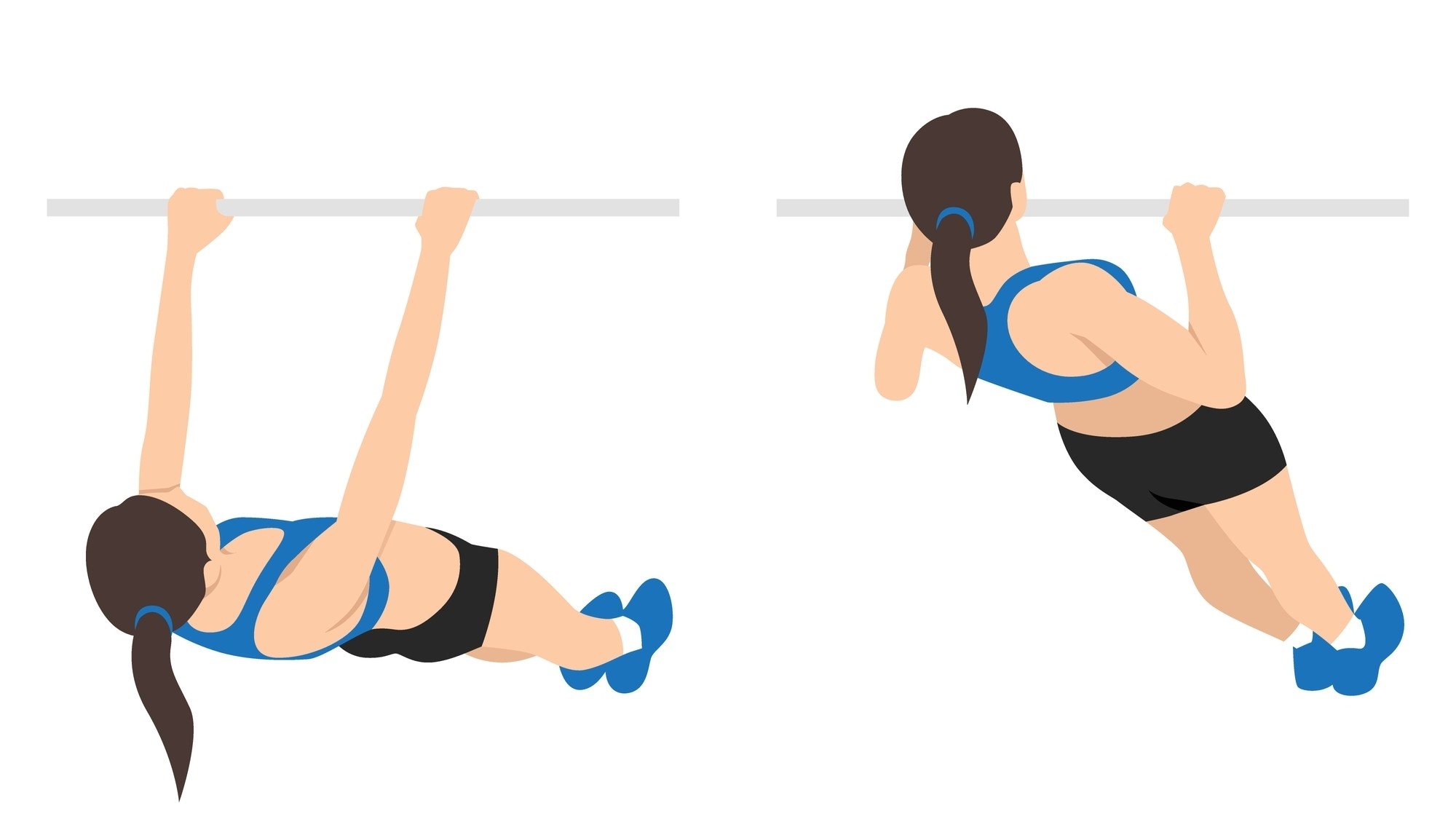
Also known as body rows, these beginner-friendly calisthenics biceps exercises build endurance and improve pulling strength. Great for all levels, they’re easily scalable by adjusting bar height and body angle.
Setup:
- Locate a horizontal bar for these foundational calisthenics exercises.
- Position yourself correctly during your developmental calisthenics workout.
- Grasp the bar with one hand for these focused calisthenics biceps exercises.
- Create stability before initiating the pulling movement.
Execution:
- Begin with your working arm fully extended.
- Pull your chest toward the bar during these controlled calisthenics exercises.
- Maintain body stability throughout your intensive calisthenics workout.
- Return to the start position while performing these effective calisthenics biceps exercises.
10. Pelican Curls

Pelican curls combine mobility and strength, offering deep biceps activation through an extended range of motion. As one of the more advanced calisthenics biceps exercises, it challenges joint control and muscular coordination.
Setup:
- Mount parallel bars for these advanced calisthenics exercises.
- Position yourself properly for your challenging calisthenics workout.
- Lean forward while maintaining these demanding calisthenics biceps exercises.
- Engage your core with proper thoracic positioning.
Execution:
- Lower your chest forward with complete muscular control.
- Curl your body upward using focused bicep engagement.
- Hold the peak contraction during these intensive calisthenics exercises.
- Return to the starting position with deliberate control movements.
11. Korean Dips

Though primarily a triceps and shoulder movement, Korean dips also engage the biceps through stabilization and range extension. It’s a powerful upper-body movement for any calisthenics biceps workout routine.
Setup:
- Position yourself between parallel bars to begin these challenging calisthenics exercises.
- Establish a neutral grip while preparing for this intensive calisthenics workout.
- Align your body properly for these demanding calisthenics biceps exercises.
- Create full-body tension before initiating the movement pattern.
Execution:
- Lower your body behind the bars with complete control during these dynamic calisthenics exercises.
- Keep your elbows close to your body throughout your focused calisthenics workout.
- Push back to the starting position while performing these progressive calisthenics biceps exercises.
- Maintain strict alignment throughout each repetition of the movement.
Pro Tips:
- Master regular dips before attempting these advanced calisthenics exercises.
- Progress gradually while following your structured calisthenics workout.
- Focus on constant tension during these specialized calisthenics biceps exercises.
- Listen to your body and adjust intensity as needed for optimal progress.
12. Side Plank

While not a direct calisthenics biceps exercise, side planks enhance arm stability and shoulder engagement. They’re valuable for building the endurance needed to hold positions in biceps-dominant movements.
Setup:
- Begin this foundational calisthenics biceps exercise by positioning yourself on your side with your entire body stretched out in a straight line from head to toe.
- As you prepare for these advanced calisthenics biceps exercises, carefully position your supporting elbow directly underneath your shoulder for proper vertical alignment.
- Stack both feet precisely on top of each other, maintaining proper form that’s essential.
- Choose your arm position based on your stability level – either keep it resting along the side of your body or extend it toward the ceiling.
- Establish a strong foundation similar to other calisthenics biceps exercises by pressing your entire forearm firmly against the ground.
Execution:
- Initiate this challenging calisthenics biceps exercise by pressing firmly through your forearm to lift your hips off the ground.
- Engage your core by drawing your navel toward your spine throughout the movement.
- Focus on creating a straight line while maintaining the form required for effective calisthenics biceps exercises.
- Maintain the position while establishing a steady breathing pattern that helps sustain proper form in these advanced calisthenics biceps exercises.
- Keep your neck neutral, a crucial aspect of all calisthenics biceps exercises, by focusing your gaze directly ahead.
- Concentrate on keeping your hips elevated and stable, as stability is key in these foundational calisthenics exercises.
- Continuously engage your supporting muscles as you would in other intensive calisthenics biceps exercises.
Pro Tips:
- Apply the same attention to form as in other calisthenics biceps exercises by visualizing a straight rod through your body.
- Enhance your stability by actively pulling your shoulder blade down and back.
- Create maximum stability by pressing your entire forearm firmly into the ground.
- Prevent strain during these challenging calisthenics biceps exercises by keeping your working shoulder pulled down and away from your ear.
Understanding the Anatomy of the Biceps for Calisthenics Biceps Exercises
Knowledge of biceps anatomy is essential for optimizing your calisthenics training. Understanding how these muscles function allows you to target them more effectively, leading to better strength development and more efficient movement patterns in your bodyweight exercises.

Biceps Brachii: The Star Muscle
The biceps brachii consists of two distinct heads: the long head, which forms the outer portion, and the short head, which contributes to the inner bulk of the bicep. This muscle is primarily responsible for elbow flexion, enabling you to bend your arm, and forearm supination, allowing you to turn your palm upwards during calisthenics biceps exercises. Additionally, the biceps play a vital role in shoulder stability and arm rotation, making it essential for many movements in a calisthenics workout.
Brachialis: The Hidden Helper
Beneath the biceps lies the brachialis, a crucial muscle that powers elbow flexion and provides necessary stability during various calisthenics workouts. Although it may not be as visible, the brachialis enhances overall arm strength, making it a vital component in calisthenics biceps exercises. By targeting this muscle, you can achieve a more balanced and powerful arm.
8 Best Bodyweight Bicep Exercises:
These carefully selected movements represent the most effective bodyweight exercises for bicep development, ranging from beginner-friendly to advanced variations. Each exercise targets the biceps through different angles and movement patterns, ensuring comprehensive muscle activation. Mastering these fundamental movements provides the foundation for building impressive arm strength and size without any equipment required.
- Chin-ups: The gold standard for bicep development, focusing on full range of motion
- Tactical Body Rows: Underhand grip rows using a table or bar at waist height with feet on ground
- Pelican Curls: Advanced movement using parallel bars or rings that isolates bicep contraction
- Commando Pull-ups: Alternating grip movement pattern that creates unilateral loading
- Ring Bicep Curls: Using suspension training to create a curl pattern with adjustable difficulty
- One-arm Negative Chin-ups: Controlling the descent with one arm to build eccentric strength
- L-sit Chin-ups: Adding core engagement to increase overall difficulty and stabilization demands
- Doorway Curls: Using a doorframe for leverage to perform isometric or concentric bicep contractions
Incorporate 2-3 of these movements into each arm training session, selecting exercises appropriate to your current strength level. Focus on perfect form rather than maximum repetitions for optimal results.
Can Calisthenics Build Biceps?
The short answer is absolutely yes! Calisthenics can effectively build impressive biceps when executed with proper technique and progressive programming. While the approach differs from traditional weight training, bodyweight movements provide all necessary stimuli for muscle growth. Understanding the science and application reveals how to maximize bicep development without equipment.
- Progressive Overload: Modify leverage and body position to increase resistance
- Mechanical Tension: Implement tempo manipulation to increase time under tension
- Metabolic Stress: Structure workouts with appropriate volume and limited rest periods
- Range of Motion: Ensure complete lengthening and shortening of the biceps
- Mind-Muscle Connection: Focus on feeling the biceps working through each repetition
- Consistency: Maintain regular training frequency (2-3 dedicated sessions weekly)
- Recovery: Allow adequate rest between intense training sessions
- Nutrition: Support muscle development with appropriate protein intake
While equipment-free bicep training might not produce the same hypertrophy as heavy weight training in shorter timeframes, many athletes have developed impressive arms through bodyweight-only approaches. The key lies in proper progression, variety, and training intensity rather than simply adding external load.
Ready to master advanced skills? Learn how to progress toward the impressive calisthenics planche and build incredible upper body strength.
What are the Benefits Of Training Biceps Through Calisthenics?
Bodyweight bicep training offers distinct advantages that traditional weight training simply cannot match. From enhanced joint health to improved functional strength, calisthenics provides a comprehensive holistic approach to arm development. These unique benefits make bodyweight training particularly valuable for sustainable long-term muscle growth, injury prevention, and overall athletic performance enhancement.
- Joint Health: The natural movement patterns reduce stress on elbow and wrist joints compared to heavy curls
- Functional Strength: Develops biceps in coordination with supporting muscles, creating strength that transfers to real-world activities
- Improved Body Awareness: Builds proprioception and kinesthetic sense through complex movement patterns
- Accessibility: Requires minimal or no equipment, allowing for consistent training regardless of location
- Progressive Challenge: Offers infinite progression possibilities through leverage adjustments rather than simply adding weight
- Injury Prevention: Develops balanced strength throughout the entire upper arm and supporting structures
- Core Integration: Engages core stabilizers during most movements, creating full-body development
- Grip Strength: Simultaneously develops forearm and grip strength critical for advanced bodyweight skills
These benefits make arm bodyweight training particularly valuable for athletes, travelers, and those seeking sustainable long-term development.
Can You Grow Your Biceps With Bodyweight Movements?
Many fitness enthusiasts wonder if bodyweight training alone can build impressive biceps without weights or gym equipment. The answer is definitively yes—bodyweight exercises can effectively stimulate bicep hypertrophy when executed strategically. Understanding the science and practical application reveals how to maximize muscle growth through intelligent programming.
1. Scientific Support:
- Mechanical tension, metabolic stress, and muscle damage—the three primary hypertrophy mechanisms—can all be achieved through bodyweight exercises
- EMG studies show significant bicep activation during various pulling movements, particularly with supinated (underhand) grip
- Progressive overload can be applied through leverage manipulation rather than adding external weight
- Time under tension can be optimized through tempo manipulation and isometric holds
2. Practical Considerations:
- Advanced practitioners may eventually need to add weight for continued growth
- Progress requires systematic intensity increases as adaptation occurs
- Higher training frequency may be beneficial (2-3 dedicated arm sessions weekly)
- Nutrition must support muscle growth (sufficient protein and overall calories)
- Recovery becomes increasingly important as training intensity increases
While genetics influence ultimate bicep development potential, virtually everyone can experience significant growth through properly programmed bodyweight arm training. The key differentiator is not whether growth occurs, but rather the rate of development compared to weighted exercises.
Want to train anywhere without equipment? Discover our complete guide to calisthenics at home with no equipment and never miss a workout again.
3 Tips to Keep in Mind When Doing a Bodyweight Exercise?
Bodyweight exercises offer incredible versatility and effectiveness, but proper execution is crucial for maximizing results and preventing injury. Unlike weighted movements, bodyweight training requires specific attention to form, progression, and body positioning. Understanding these fundamental principles ensures you harness the full potential of calisthenics training.
1. Correct Posture:
- Focus on quality over quantity – perfect repetitions build better results than sloppy volume
- Maintain body alignment throughout movements to maximize target muscle engagement
- Control negative (lowering) phases to increase time under tension
- Eliminate momentum and swinging that reduces muscle stimulation
- Record yourself periodically to assess form objectively
2. Correct Procedure:
- Progressive overload must be implemented systematically
- Train to technical failure rather than absolute failure for optimal results
- Structure appropriate volume (sets/reps) based on your experience level
- Allow adequate recovery between intense training sessions
- Implement deload periods every 4-6 weeks to prevent overtraining
3. Execution Techniques:
- Establish mind-muscle connection by focusing on feeling the target muscles work
- Utilize tempo manipulation to increase time under tension
- Implement strategic pauses at peak contraction points
- Control breathing patterns to enhance performance
- Maintain consistent training frequency (2-3 sessions weekly) for optimal results
Applying these principles to your bodyweight bicep training creates the foundation for continuous progress while minimizing injury risk.
What are advantages of Training Biceps Through Calisthenics?
While many associate calisthenics primarily with chest, back, and leg development, bodyweight bicep training offers unique advantages for arm development:
- Develops functional strength that translates to real-world movements
- Engages stabilizing muscles overlooked in isolation training
- Creates balanced muscle development across the entire arm
- Reduces joint stress compared to heavy barbell/dumbbell curls
- Requires minimal equipment, making training accessible anywhere
- Promotes greater mind-muscle connection through complex movement patterns
- Integrates naturally with full-body training systems
Approaching arm bodyweight exercises systematically allows for continuous progression while minimizing injury risk. The foundation of effective bicep development lies in understanding movement mechanics and implementing proper progressions.
Curious about muscle building potential? Explore the science behind whether calisthenics builds muscle and maximize your training results.
What Bodyweight Exercises Work well with the Triceps?
Building impressive triceps through bodyweight training requires targeting this three-headed muscle group with strategic exercise selection. The triceps comprise roughly two-thirds of your upper arm mass, making them essential for balanced development. Effective bodyweight movements can provide substantial tricep stimulation through varied angles and progressive difficulty levels.
Primary Tricep Builders:
- Diamond Push-ups: Position hands together to create diamond shape under chest
- Bench Dips: Using a bench or chair for dips with feet extended
- Bodyweight Skull Crushers: Using self-resistance to create tricep extension
- Push-up Variations: Standard, decline, and pike push-ups engage triceps significantly
- Tricep Extensions: Using resistance band or suspension trainer
Advanced Movements:
- Ring Dips: Using gymnastics rings for greater range of motion
- Tiger Bend Push-ups: Advanced push-up variation with intense tricep focus
- Korean Dips: Reverse direction dips that emphasize tricep development
- Handstand Push-ups: Develops tremendous tricep strength in vertical position
- Planche Progressions: Advanced gymnastics movements with significant tricep demand
Integrating these movements with your bodyweight bicep training creates balanced arm development for both aesthetics and functional performance.
Biceps Calisthenics Workout Routine
This complete bodyweight program maximizes bicep development through strategic exercise selection and progressive overload principles. The routine combines foundational pulling movements with advanced variations to challenge your biceps effectively. Following proper warm-up protocols and structured progression ensures optimal muscle growth while minimizing injury risk for sustainable long-term results.
This specialized routine targets maximum bicep development:
| Phase | Exercise | Sets x Reps | Notes |
| Warm-up (5 minutes) | Arm circles | 20 forward, 20 backward | Prepare shoulder joints |
| Wrist rotations | 15 each direction | Activate wrist mobility | |
| Scapular pull-ups | 10 repetitions | Engage back muscles | |
| Dead hangs | 30 seconds | Build grip strength | |
| Band pull-aparts | 15 repetitions | Activate rear delts | |
| Main Workout | Chin-ups | 4 sets of 6-10 reps | Primary bicep builder |
| Commando Pull-ups | 3 sets of 6-8 reps | Alternating sides | |
| Underhand Inverted Rows | 3 sets of 10-12 reps | Controlled movement | |
| Isometric Chin-up Holds | 3 sets of 20-30 seconds | Top position hold | |
| Bodyweight Bicep Curls | 3 sets of 8-12 reps | Focus on contraction | |
| Finisher | 21s Protocol | 1 set | 7 bottom + 7 top + 7 full |
| Cool-down | Bicep stretches | 30 seconds each arm | Maintain flexibility |
| Wrist stretches | 30 seconds each position | Prevent tightness | |
| Forearm massage | 60 seconds each arm | Promote recovery |
Perform this routine 2-3 times weekly with at least 48 hours between sessions for optimal bicep development. Progress by increasing repetitions before advancing to more challenging variations.
Conclusion
Calisthenics biceps exercises provide a practical, effective approach to arm development that’s accessible anywhere, anytime. The progressive nature of these movements of calisthenics workout allows practitioners to continually challenge themselves while building functional strength and muscle mass. Through proper application of leverage, angles, and progressive overload principles, calisthenics workout can develop impressive biceps strength and size using only bodyweight resistance. This approach proves that expensive equipment isn’t necessary for remarkable results.
Find out the truth in Does Calisthenics Build Muscle and see how effective calisthenics really is
If you’re serious about mastering Calisthenics Biceps Exercises and want expert support to improve your technique, strength, and recovery, connect with the professionals at ISC – Indian School of Calisthenics. Their certified coaches offer personalized training programs tailored to your fitness level, whether you’re a beginner or looking to break through plateaus. For one-on-one coaching, group sessions, or detailed progression plans, visit them at ISC – Indian School of Calisthenics, SRPF Ground, NH8, Goregaon (E), Mumbai – 400065 or call +91 77159 53218.
Calisthenics Biceps Exercises – FAQs
How often should I train biceps with calisthenics?
Train biceps 2-3 times per week, allowing 48-72 hours between sessions for recovery.
Can I build big biceps with just bodyweight exercises?
Yes, consistent practice of progressive calisthenics biceps exercises can build significant muscle mass.
How many chin-ups should I aim for?
Begin with quality over quantity. Start with 3 sets of perfect form chin-ups calisthenics workout, even if assisted, and gradually increase.
Should I train to failure?
Occasionally training to failure can be beneficial, but focus on quality repetitions with 1-2 reps in reserve most of the time.
How long before seeing results?
With consistent training, noticeable improvements in strength can occur within 4-6 weeks, with visible changes in 8-12 weeks.
Can I combine these exercises with weight training?
Yes, calisthenics biceps exercises can complement traditional weight training effectively.
How many chin-ups should I aim for?
Aim for at least 8–12 clean chin-ups per set as a benchmark. Increase reps or difficulty to progress your calisthenics biceps workout.

